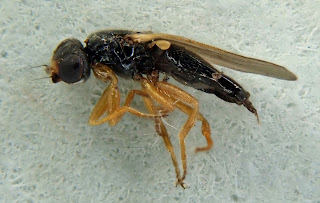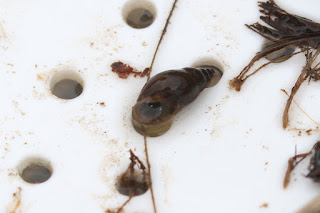Wednesday 15th February 2023, Buttery Farm, Kynnersley
Buttery Farm is an arable farm on the Weald Moor close to Kynnersley. Most of its land is dedicated to growing Elephant grass for biofuel production but it also has some wilder areas which we explored.
We parked in Kynnersley and walked the mile or so to the site along the track known as Kynnersley Drive. The track is like a Roman Road – straight. Here it is from just over half way along.
Where we were headed was the line of trees in the distance.
Needless to say some took the early morning stroll at a faster pace and some lagged behind.
However, the laggers were not idle. On the way they found an “inconspicuous” ladybird, Rhyzobius lophanthe.
 |
| Photograph: David Williams |
And this patch of Snowdrops.
 |
| Photograph: David Williams |
Eventually we got to the site.
We spent the rest of the morning exploring the rough grassland and trees around the pool.
Funaria hygrometrica:
 |
| Photograph: John Martin |
Rhyzobius litura and a 24-spot ladybird:
 |
| Photograph: David Williams |
Juniper shieldbug:
 |
| Photograph: Nigel Cane-Honeysett |
A staphylinid beetle, Hygronoma dimidiata:
 |
| Photograph: Nigel Jones |
A second staphylinid, Metopsia clypeata:
 |
| Photograph: Nigel Jones |
Exhausted by our long walk and morning searches we moved to the neighbouring reservoir and settled down for lunch and a breather.
 |
| Photograph: Nigel Cane-Honeysett |
There were some Reedmace in front of where we were so one brave (or foolhardy) person went to check them for signs of life. He found Water ladybirds.
 |
| Photograph: David Williams |
Lunch over we moved around to the far side of the reservoir and into an area of marshy ground which was not very marshy following the recent lack of rain.
 |
| Photograph: John Martin |
A rather dishevelled Harvest mouse nest was discovered amongst some dead vegetation.
 |
| Photograph: Neil Nash |
And in a wetter area there was a Water vole larder.
 |
| Photograph: Neil Nash |
We moved to a drier area where we looked at the vegetation under a hedge. Suction sampling collected this mite – we have no idea what species it is.
.jpg) |
| Photograph: David Williams |
Suction sampling was a good was of collecting grains of soil and although sifting through soil was exciting for some others were waiting to move on.
 |
| Photograph: Nigel Cane-Honeysett |
And was this wait worthwhile?
Yes!
A staphylinid beetle hardly bigger than some of the larger particles was spotted.
 |
| Photograph: David Williams |
It was later identified as Micropeplus staphylinoides.
The waiting over the nearby woodland next attracted our attention.
A collection of feather was observed. Here are a selection.
 |
| Photograph: David Williams |
They were identifies as Barn owl feathers. There were plenty of feathers but no sign of a carcass. This was a puzzle that none of our theories explained satisfactorily.
Time to start the long walk back to the cars.
On the way we found something of great interest.
Many were drawn to this attraction, but others were able to resist and satisfied themselves checking a further selection of vacuumed items.
Two more ladybirds were found, a 16-spot and 22-spot:
 |
| Photograph: David Williams |
A micro-moth, Agonopterix heracliana:
 |
| Photograph: John Martin |
And a NEW COUNTY RECORD, the fly Oscinisoma gilvipes:
 |
| Photograph: Nigel Jones |
On the way back some Hebridean sheep pondered on the meaning of life and why this group of weary people spent their time grubbing around all day apparently enjoying themselves.
 |
| Photograph: John Martin |
Wednesday 22nd February 2023, Brown Moss
"Please check for Pond mud snails and keep a look out for a Terrapin" was the request when I asked Shropshire County Council for permission to visit the site with the group.
Fortunately a member of the group was able to supply an article on Pond mud snails, how to look for them and bring a sieve.
When I arrived he was already at work sieving the shallow water at the edge of the lake pool. He found some snails but none fitted the description of our target snail species.
We moved to a smaller pool and our sifter tried again. Was he successful?
You will have to wait to find out.
Meanwhile the rest of us contented ourselves with not looking for Pond mud snails. In and around the pool we did find:
A beetle, Chrysolina polita;
Flushed with Water vole success the previous week we found another larder;
Another beetle, Oulema melanolopus or rufocyanea – they can only be separated by microscopic examination;
 |
| John Martin |
A further beetle, Prasocuris phellandrii;
 |
| Photograph: Nigel Jones |
A shore bug, Chartoscirta cincta;
 |
| Photograph: Nigel Jones |
And yet another beetle, which has not been identified.
 |
| Photograph: John Martin |
All these beetles involved a lot of staring into trays.
And what does that person have in his sieve?
Patience.
It started to rain.
It poured down.
We scurried to the porous shelter of some conifers, continued to look into trays and had lunch.
The rain stopped, the sun came out and lunch was finished, allowing us to emerge and move to the area of the site that houses a schwingmoor or quaking bog. On the way we noticed that quite a bit of tree felling had been carried out giving the land a rather forlorn appearance.
The schwingmoor was situated in this area.
The surface of the bog is a thick, dense mat of moss that floats on underlying water. Two of the mosses present were:
Polytrichum commune;
 |
| Photograph: John Martin |
And Sphagnum palustre.
 |
| Photograph; John Martin |
Searching the area around the bog we found:
Another beetle that defied our attempts to identify it on the day;
 |
| Photograph: Nigel Cane-Honeysett |
A fungus known as Crimped gill, Plicaturopsis crispa;
 |
| Photograph: John Martin |
And a collection of Glistening inkcap on dead wood.
Onto another pool we moved.
And then into a wet meadow.
Here we continued with our ability not to be able to identify a beast when we found this millipede.
 |
| Photograph; Nigel Cane-Honeysett |
I now defer to my colleague to provide the commentary for the next four photographs.
“What’s this Nigel has given me?”
“Is that a Higg's Boson?”
“Still can’t wok it out”
“Oh it’s a pooter”
 |
| Photograph: Nigel Cane-Honeysett |
After all this activity the samplers were given a well-earned rest!
And we went home.
But I think I have forgotten something …
Pond mud snails.
Yes, there was one in his sieve, later confirmed by the County Recorder.
Here it is.
 |
| Photograph: John Martin |
And the Terrapin? It is still at large.
Thank you to the owners of Buttery Farm and Shropshire County Council for giving us permission to enjoy ourselves and to the photographers for their many and varied images to illuminate the tale.




















.JPG)


.JPG)


.jpg)
.jpg)
































